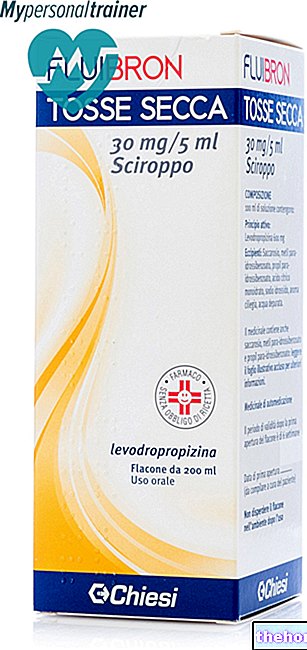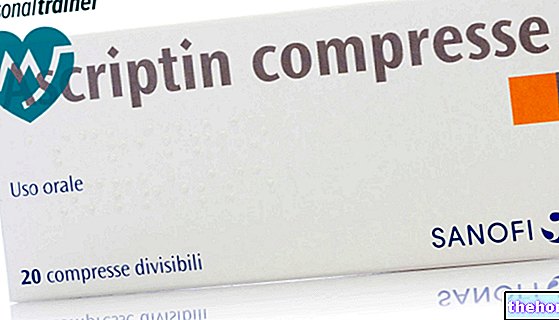Active ingredients: Brimonidine
Brimonidina Sandoz 2 mg / ml eye drops, solution
Why is Brimonidine used - Generic drug? What is it for?
Brimonidine Sandoz 2 mg / ml eye drops, solution contains brimonidine tartrate, which works by reducing the pressure in the eye.
The eye drops are used in adults with glaucoma or ocular hypertension to reduce the increase in pressure in the eye caused by a buildup of fluid. The eye drops can be used alone or in combination with other medicines that reduce the pressure inside the eyeball.
Contraindications When Brimonidine should not be used - Generic drug
Do not use Brimonidina Sandoz 2 mg / ml eye drops, solution:
- In the case of infants and children (from birth up to 2 years of age).
- If you are allergic to brimonidine tartrate or any of the other ingredients of Brimonidine Sandoz 2 mg / ml eye drops, solution (listed in section 6).
- If you are being treated with certain antidepressants (monoamine oxidase inhibitors (MAO and other antidepressants).
- If you are taking any antidepressant medicines you should tell your doctor.
Precautions for use What you need to know before taking Brimonidine - Generic drug
Talk to your doctor or pharmacist before using Brimonidina Sandoz 2 mg / ml eye drops, solution:
- if you have or have suffered from depression;
- if you have a reduced mental capacity;
- if you have heart problems;
- if you have a reduced blood supply to the brain;
- if you have reduced blood flow to the limbs;
- if you have low blood pressure complaints, particularly when standing up;
- if you have or have ever had kidney or liver problems;
- if you wear soft contact lenses (see section 3);
- if you are to give the medicine to a child over 2 years old as the use of Brimonidina Sandoz 2 mg / ml eye drops solution is not recommended in patients of this age.
Interactions Which drugs or foods can modify the effect of Brimonidine - Generic drug
Tell your doctor or pharmacist if you are using, have recently used or might use any other medicines. You should tell your doctor if you are taking or have recently taken any of the following medicines:
- pain relievers, sedatives, opiates, barbiturates, or is a regular user of alcohol
- anesthetics
- to treat heart disease or to lower blood pressure
- treating a nervous system disorder (chlorpromazine, methylphenidate and reserpine)
- which act on the same receptor as brimonidine, for example isoprenaline and prazosin
- monoamine oxidase (MAO) inhibitors and other antidepressants
- medicines for any other situation, even if not related to your eye problems
Brimonidina Sandoz 2 mg / ml eye drops, solution with alcohol
You should tell your doctor if you regularly consume alcohol.
Warnings It is important to know that:
Pregnancy and breastfeeding
If you are pregnant or breast-feeding, think you may be pregnant or are planning to have a baby, ask your doctor or pharmacist for advice before using this medicine.
If you are pregnant or if you suspect that you are pregnant, you should use Brimonidina Sandoz 2 mg / ml eye drops, solution only if clearly needed.
Do not use these drops if you are breastfeeding.
Driving and using machines
This eye drops can cause blurred or abnormal vision. This effect can worsen at night or in low light conditions. Brimonidine Sandoz 2 mg / ml eye drops solution may also cause drowsiness or tiredness in some patients. If you experience any of these symptoms, do not drive or operate machinery until the symptoms have disappeared.
Brimonidina Sandoz 2 mg / ml eye drops, solution contains benzalkonium chloride
A preservative (benzalkonium chloride) in these eye drops can cause eye irritation. Avoid contact with soft contact lenses as this component is known to discolor soft contact lenses. If you wear soft contact lenses, remove them before fitting and then wait at least 15 minutes after use before re-applying them.
Dose, Method and Time of Administration How to use Brimonidine - Generic drug: Posology
Always take Brimonidina Sandoz 2 mg / ml eye drops solution, exactly as your doctor has told you. If in doubt, consult your doctor or pharmacist.
Dosage and frequency of administration
Apply 1 drop of Brimonidina Sandoz 2 mg / ml eye drops, solution twice daily into the affected eye (s), approximately 12 hours apart. If using with other eye drops, wait 5-15 minutes before applying the second eye drops.
To be effective, this eye drops should be used every day.
Children under 12 years old
Brimonidina Sandoz 2 mg / ml eye drops, solution should not be given to children under 2 years of age.
The use of Brimonidina Sandoz 2 mg / ml eye drops, solution is not recommended in children (from 2 years to 12 years of age).
Method of administration
Brimonidina Sandoz 2 mg / ml eye drops, solution is for ocular use.
Follow the instructions on your prescription carefully and ask your doctor or pharmacist to explain anything you don't understand.
Always wash your hands before applying the eye drops. Apply the eye drops following the instructions below:
- You put your head back and look up.
- Slowly pull the lower lid down to form a small pocket.
- Turn the bottle upside down and apply gentle pressure to push a drop of eye drops into the eye.
- While holding the eye closed, press your finger on the corner of the closed eye (the part where the eye meets the nose) and hold for one minute.
Do not let the tip of the bottle touch your eye or anything else. Put the cap back on immediately after use.
If you wear soft contact lenses, remove them before using this eye drop and wait 15 minutes after applying the drops before inserting them again. The preservative in these eye drops is known to discolor soft contact lenses.
If you forget to take Brimonidina Sandoz 2mg / ml eye drops, solution
If you forget to apply this medicine, apply it as soon as you remember.
If it is almost time to apply the next dose, skip the missed dose and wait until your usual time and continue with your usual routine.
Do not apply a double dose to make up for a forgotten dose.
If you stop taking Brimonidina Sandoz 2 mg / ml eye drops, solution
To be effective Brimonidina Sandoz 2 mg / ml eye drops, solution should be used every day. Do not stop treatment until your doctor tells you to.
If you have any further questions on the use of this medicine, ask your doctor or pharmacist.
Overdose What to do if you have taken an overdose of Brimonidine - Generic Drug
Adults
There is limited experience in adults of an overdose of Brimonidine Sandoz 2 mg / ml eye drops solution. It is unlikely when given as eye drops. In cases received, reported events have generally been those already listed as adverse reactions.
Adults who accidentally ingested brimonidine experienced a decrease in blood pressure, which in some patients was followed by an increase in blood pressure.
Children
A few cases of overdose have been reported in children who received Brimonidine Sandoz 2 mg / ml eye drops, solution as part of a drug treatment of glaucoma. Symptoms include reversible coma or loss of consciousness, tiredness, drowsiness, weakness, slow heart rate. , low body temperature, paleness and difficulty in breathing. If this happens, contact your doctor immediately.
Adults and children
For other alpha-2-agonists, a group of drugs to which brimonidine also belongs, oral overdoses have been reported to cause symptoms such as low blood pressure, feeling of weakness, vomiting, lethargy, sedation, slow heart rate, heart rate irregular, contraction of the pupils, weakness, low body temperature, difficulty breathing and cramps.
Brimonidina Sandoz 2 mg / ml eye drops, solution can act in a similar way. Brimonidine Sandoz 2 mg / ml eye drops, solution is for application to the eyes only. If you or your child accidentally swallow these drops or use more than you should, contact your doctor immediately.
Side Effects What are the side effects of Brimonidine - Generic drug
Like all medicines, Brimonidina Sandoz 2 mg / ml eye drops, solution can cause side effects, although not everybody gets them.
Some of the effects on your eye (s) may be due to an allergy to the active substance or to any of the excipients (see end of section 2 and section 6). The following effects can occur:
- an allergic reaction in the eye
- follicles or white spots on the conjunctiva (the membrane that covers the outer surface of the eyelids)
- blurred vision
- redness of the eyes
- burning, tingling, a sensation of something in the eye
- itch
- headache
- tiredness / sleepiness
- dry mouth
- changes in the surface of the eye
- inflammation of the eyelids
- inflammation of the conjunctiva
- vision disturbances
- sticky eyes
- swelling of the eyelid or conjunctiva
- sensitivity to light
- irritation
- redness of the eyelids
- pain in the eyes
- dry eyes
- eye surface erosion and staining
- tears
- whitening of the conjunctiva
- dizziness
- gatrointestinal symptoms
- flu-like symptoms
- general weakness
- general allergic reactions
- depression
- palpitations
- changes in heart rate
- nasal dryness
- sore throat
- nausea
- taste disturbances
- inflammation of the skin with rashes
- thirst
- shortness of breath
- seasonal allergy
- high or low blood pressure
- voice disorder
- cough
- nasal congestion
- dry throat
- inflammation of the eye
- reduction in pupil size
- fainting
- insomnia
- inflammation of the internal parts of the eye causing pain and redness
- itchy eyelid
- skin reactions including redness of the skin, swelling of the face, itching, rash, vasodilation
Reporting of side effects
If you get any side effects, talk to your doctor. This includes any possible side effects not listed in this leaflet. You can also report side effects directly via the national reporting system at www.agenziafarmaco.gov.it/it/responsabili. By reporting side effects you can help provide more information on the safety of this medicine.
Expiry and Retention
Keep this medicine out of the sight and reach of children.
This medicine does not require any special storage conditions.
Do not use Brimonidina Sandoz 2 mg / ml eye drops, solution after the expiry date which is stated on the carton and vial. The expiry date refers to the last day of that month.
After first opening: use within 28 days.
Do not use the drug if the security seal on the bottle is broken before the first use.
Do not throw any medicines via wastewater or household waste. Ask your pharmacist how to throw away medicines you no longer use. This will help protect the environment.
Other information
What Brimonidina Sandoz 2mg / ml eye drops, solution contains
- The active ingredient is: brimonidine tartrate. 1 ml of solution contains 2 mg of brimonidine tartrate, equivalent to 1.3 mg of brimonidine.
- The other ingredients are: benzalkonium chloride, polyvinyl alcohol, sodium chloride, sodium citrate, citric acid monohydrate, purified water and sodium hydroxide and hydrochloric acid for pH adjustment.
What Brimonidina Sandoz 2 mg / ml eye drops, solution looks like and contents of the pack
Brimonidina Sandoz 2 mg / ml eye drops, solution is a clear, slightly greenish-yellow solution.
The eye drops are available in 5 ml bottles with droppers in packs of 1, 3 or 6 and in 10 ml bottles with droppers in packs of 1 or 3.
Not all pack sizes may be marketed.
Source Package Leaflet: AIFA (Italian Medicines Agency). Content published in January 2016. The information present may not be up-to-date.
To have access to the most up-to-date version, it is advisable to access the AIFA (Italian Medicines Agency) website. Disclaimer and useful information.
01.0 NAME OF THE MEDICINAL PRODUCT
BRIMONIDINE SANDOZ 2 MG / ML EYE DROPS, SOLUTION
02.0 QUALITATIVE AND QUANTITATIVE COMPOSITION
One ml of solution contains 2 mg of brimonidine tartrate, equivalent to 1.3 mg of brimonidine.
Excipient (s) with known effect: benzalkonium chloride 0.05 mg / ml
For the full list of excipients, see section 6.1.
03.0 PHARMACEUTICAL FORM
Eye drops.
Clear, slightly greenish-yellow solution.
04.0 CLINICAL INFORMATION
04.1 Therapeutic indications
Reduction of elevated intraocular pressure (IOP) in adults with open angle glaucoma or ocular hypertension.
• As monotherapy in patients for whom topical therapy with beta-blockers is contraindicated.
• As add-on therapy to other medicinal products that lower intraocular pressure when the desired IOP is not achieved with a single agent (see section 5.1).
04.2 Posology and method of administration
Dosage
Recommended dose in adults (including elderly patients)
The recommended dose is one drop of Brimonidina Sandoz 2 mg / ml eye drops, solution in the affected eye (s), twice a day, approximately 12 hours apart. No dose adjustment is necessary in elderly patients.
Patients with renal and hepatic impairment
No studies have been conducted on the use of brimonidine in patients with hepatic or renal impairment (see section 4.4).
Pediatric population
No clinical studies have been performed in adolescents (12 to 17 years).
The use of Brimonidina Sandoz 2 mg / ml eye drops, solution is not recommended in children below 12 years and is contraindicated in newborns and infants (less than 2 years old - see sections 4.3, 4.4, 4.8 and 4.9). It is known that serious adverse reactions can occur in infants. The safety and efficacy of brimonidine have not been established in infants.
Method of administration
As with all eye drops, it is recommended to compress the lacrimal sac at the medial canthus (puncture occlusion) for 1 minute in order to reduce possible systemic absorption. This must be done immediately after applying each drop.
In case of concomitant administration of other topical ophthalmic products, these should be instilled 5-15 minutes apart.
04.3 Contraindications
• Newborns and infants less than 2 years of age (see sections 4.4 and 4.8) Hypersensitivity to the active substance or to any of the excipients listed in section 6.1
• Concomitant treatment with monoamine oxidase inhibitors (MAOIs)
• Concomitant treatment with antidepressants that affect noradrenergic transmission (eg tricyclic antidepressants and mianserin).
04.4 Special warnings and appropriate precautions for use
Caution should be exercised in the treatment of patients with severe or unstable and uncontrolled cardiovascular disease.
In clinical trials some patients (12.7%) developed an allergic-type ocular reaction (for further details see section 4.8). If allergic reactions are observed, treatment with Brimonidina Sandoz 2 mg / ml eye drops, solution should be discontinued.
Delayed ocular hypersensitivity reactions have been reported with brimonidine 0.2%, some of which have been reported to be associated with an increase in IOP.
Brimonidine Sandoz 2 mg / ml eye drops, solution should be used with caution in patients with depression, cerebral or coronary insufficiency, Raynaud's phenomenon, orthostatic hypotension or obliterating thrombangitis.
Brimonidine has not been studied in patients with hepatic or renal insufficiency; such patients should be treated with caution.
Pediatric population
Bromidine eye drops are not recommended in children over 2 years of age due to potential central nervous system (CNS) depression (see sections 4.8 and 4.9).
The preservative contained in Brimonidina Sandoz 2 mg / ml eye drops, solution (benzalkonium chloride) may cause eye irritation.
Avoid contact with soft contact lenses. Remove contact lenses before instillation and wait at least 15 minutes before putting them back on. Benzalkonium chloride is known to discolor soft contact lenses.
04.5 Interactions with other medicinal products and other forms of interaction
Brimonidine Sandoz 2 mg / ml eye drops, solution is contraindicated in patients receiving monoamine oxidase (MAO) inhibitors and in patients taking antidepressants that affect noradrenergic transmission (e.g. tricyclic antidepressants and mianserin) (see section 4.3).
Although no specific drug interaction studies have been conducted with brimonidine, the possibility that concomitant intake with central nervous system depressants (alcohol, barbiturates, opioids, sedatives or anesthetics) may cause an additive or anesthetic effect should be considered. empowering.
No data are available on the level of catecholamines in circulation after administration of brimonidine. However, caution is recommended in patients taking drugs capable of altering the metabolism and uptake of circulating amines eg chlorpromazine, methylphenidate, reserpine.
Alpha agonists, as a class, can reduce pulse and blood pressure. Caution is recommended with concomitant use of antihypertensive and / or cardiac glycosides.
Caution is also advised at the initiation (or at the time of any possible dose modification) of concomitant treatment with systemic agents (regardless of pharmaceutical form) which may interact with alpha-adrenergic agonists or interfere with their activity, such as agonists or antagonists of adrenergic receptors (e.g. isoprenaline, prazosin).
04.6 Pregnancy and breastfeeding
Pregnancy
There are no adequate data regarding the safety of use of brimonidine in pregnant women. In animal studies, brimonidine tartrate did not cause teratogenic effects.
In rabbits, administration of brimonidine tartrate at plasma levels higher than those achieved during therapy in humans caused an increase in preimplantation loss and a reduction in postnatal development. Brimonidine should only be used in pregnancy if the potential benefit for the mother overcomes the potential risk to the fetus.
Feeding time
It is not known whether brimonidine passes into human breast milk. Animal studies have shown the passage of brimonidine into rat milk. Brimonidine should not be used by breastfeeding women.
Fertility
No studies have been performed to evaluate the effect of topical ocular administration of brimonidine on fertility.
04.7 Effects on ability to drive and use machines
Brimonidine eye drops may cause tiredness and / or drowsiness, which may affect the ability to drive or use machines. Brimonidine may cause blurring and / or abnormal vision, effects which may impair the ability to drive or use machines, especially at night or in low light conditions. Patients who engage in dangerous activities should be warned of the possibility of a reduction in mental alertness. The patient should wait until these symptoms have resolved before driving or using machines.
04.8 Undesirable effects
The most commonly reported adverse reactions were dry mouth, ocular hyperaemia and burning / stinging of the eyes, all of which occurred in 22-25% of patients. They are generally transient in nature and are usually not severe enough to require discontinuation of treatment.
During the clinical trials, symptoms of ocular allergic reactions occurred in 12.7% of patients (which in 11.5% of cases led to discontinuation of therapy): in the majority of patients the onset occurred between the 3rd and 9th month.
Within each frequency class the undesirable effects are listed in decreasing order of severity. The following terminologies have been used to classify the occurrence of undesirable effects: very common (≥1 / 10); common (≥1 / 100,
The following adverse reactions have been identified in clinical practice during the post-marketing period of the reference product containing 0.2% brimonidine. Since they were reported voluntarily from a population of unknown size, the frequency cannot be estimated.
Not known:
Eye disorders
iridocyclitis (anterior uveitis)
itchy eyelid
Skin and subcutaneous tissue disorders
skin reactions including erythema, face edema, pruritus, rash and vasodilation
Pediatric population
In cases where brimonidine has been used as part of the medical treatment of congenital glaucoma, symptoms of brimonidine overdose, such as loss of consciousness, lethargy, somnolence, hypotension, hypotonia, have been reported in infants and children receiving brimonidine. bradycardia, hypothermia, cyanosis, pallor, respiratory depression and apnea (see section 4.3).
A "high prevalence of drowsiness (55%). In "8% of children" the latter manifested itself in severe form and in 13% of cases it resulted in treatment discontinuation. The incidence of somnolence decreased with increasing age, reaching the lowest in the 7-year age group (25%), but was more influenced by weight, occurring more frequently in children weighing ≤20 kg (63%) than in those weighing over 20 kg (25%).
Reporting of suspected adverse reactions
Reporting of suspected adverse reactions occurring after authorization of the medicinal product is important as it allows continuous monitoring of the benefit / risk balance of the medicinal product. Healthcare professionals are asked to report any suspected adverse reactions via the national reporting system. "address www.agenziafarmaco.gov.it/it/responsabili.
04.9 Overdose
Ophthalmic overdose (adults) :
In these cases, the reported events were generally those already listed as adverse reactions.
Systemic overdose due to accidental ingestion (adults) :
There is very limited information regarding accidental ingestion of brimonidine in adults. The only adverse event reported to date has been hypotension. The hypotensive episode has been reported to be followed by rebound hypotension approximately 8 hours. after ingestion. Both subjects recovered completely within 24 hours. In a third subject who also ingested an unknown amount of brimonidine orally, no adverse effects were noted.
Treatment of an oral overdose includes symptomatic and supportive therapy; The patient's airway must be maintained.
Oral overdose of other alpha-2-antagonists has been reported to cause symptoms such as hypotension, asthenia, vomiting, lethargy, sedation, bradycardia, arrhythmia, miosis, apnea, hypotonia, hypothermia, respiratory depression and convulsions.
Pediatric population
There have been published or reported cases of serious adverse effects due to the accidental ingestion of brimonidine by pediatric subjects. The subjects experienced symptoms of CNS depression, usually coma or decreased level of consciousness, lethargy, somnolence, hypotonia, bradycardia , hypothermia, pallor, respiratory depression, cyanosis and apnea, for which it was necessary to institute intensive care with intubation, when indicated. All subjects recovered completely, usually within 6-24 hours.
05.0 PHARMACOLOGICAL PROPERTIES
05.1 Pharmacodynamic properties
Pharmacotherapeutic group: sympathomimetics in the treatment of glaucoma
ATC code: S01EA05.
Brimonidine is an alpha-2 adrenergic receptor agonist 1000 times more selective towards alpha-2 than alpha-1. This selectivity does not cause mydriasis or vasoconstriction in the microvessels associated with human retinal xenograft. In humans, topical administration of brimonidine reduces intraocular pressure (IOP), with minimal effects on cardiovascular or pulmonary parameters.
Experience in patients with bronchial asthma is limited, however these have not experienced adverse events.
Brimonidine eye drops have a rapid onset of action, with a peak ocular hypotensive effect detectable two hours after application. In two one-year studies, brimonidine resulted in an average reduction in intraocular pressure of 4 -6 mmHg approximately.
Fluorophotometric studies in animals and humans suggest that brimonidine tartrate has a dual mechanism of action. Brimonidine is believed to decrease intraocular pressure by reducing the formation of aqueous humor and increasing uveoscleral outflow.
Clinical studies show that brimonidine eye drops are effective in combination with topical beta-blockers.
Shorter-term studies also show that these eye drops have a clinically significant additive effect when used in combination with travoprost (6 weeks) and latanoprost (3 months).
05.2 Pharmacokinetic properties
General features
Following ocular administration of a 0.2% solution twice daily for ten days, plasma concentrations were low (mean C of 0.06 ng / mL). Following multiple instillations (twice daily for 10 days) a slight accumulation in the blood was detected. The area under the plasma concentration-time curve over 12 hours at steady state (AUC0-12h) was 0.31 ng • hr / ml, compared to the value after the first dose, which was 0, 23 ng • hour / ml. In the systemic circulation the mean apparent half-life, detectable after topical administration, was approximately 3 hours.
In humans, the protein binding of brimonidine in plasma after topical administration was approximately 29%.
Brimonidine binds reversibly, in vitro And in vivo, to the melanin present in the ocular tissues. After 2 weeks of ocular instillation, the concentrations of brimonidine in the iris, ciliary body and choroid-retina were 3 to 17 times higher than the concentrations found after a single dose. The accumulation phenomenon does not occur in the absence of melanin. .
The significance of the link to melanin in humans is unclear. However, biomicroscopic examination of the eyes of patients treated with brimonidine tartrate for up to one year revealed no significant adverse reactions; furthermore, no significant ocular toxicity was found in a 1-year study to evaluate ocular safety in monkeys treated with approximately 4 times the recommended dose of brimonidine tartrate.
Following oral administration in humans, brimonidine is well absorbed and rapidly eliminated. Most of the administered dose (approximately 75%) is excreted within 5 days via the urine as metabolites; no metabolites were recovered in the urine. unchanged drug Studies in vitro, carried out on animal and human liver, indicate that metabolism is largely mediated by aldehyde oxidase and cytochrome P450. It therefore appears that systemic elimination occurs mainly at the level of hepatic metabolism.
Kinetic profile
Following single topical administrations of doses of 0.08%, 0.2% and 0.5%, no relevant deviation from dose proportionality was observed for plasma Cmax and AUC.
Characteristics in patients
Characteristics in elderly patients
Following single dose administration, the Cmax, AUC and apparent half-life of brimonidine of elderly patients (65 years and older) are similar to those of young adults: this indicates that systemic absorption and elimination do not vary. with age. Based on data from a 3-month clinical study, which included elderly patients, the systemic exposure of brimonidine was very low.
05.3 Preclinical safety data
Non-clinical data reveal no special hazard for humans based on conventional studies of safety pharmacology, repeated dose toxicity, genotoxicity, carcinogenic potential, reproductive toxicity.
06.0 PHARMACEUTICAL INFORMATION
06.1 Excipients
benzalkonium chloride polyvinyl alcohol
sodium chloride
sodium citrate
citric acid monohydrate purified water
hydrochloric acid (for pH adjustment)
sodium hydroxide (for pH adjustment)
06.2 Incompatibility
Not relevant.
06.3 Period of validity
Before opening: 2 years.
After first opening: use within 28 days.
06.4 Special precautions for storage
This medicinal product does not require any special storage conditions.
06.5 Nature of the immediate packaging and contents of the package
5 ml or 10 ml of solution contained in white low density polyethylene (LDPE) bottles, with transparent low density polyethylene (LDPE) dropper tip of about 35 microliters and with white colored dropper cap, in polyethylene with high density (HDPE).
Pack sizes: 1 x 5 ml, 3 x 5 ml, 6 x 5 ml
1 x 10ml, 3 x 10ml
Not all pack sizes may be marketed.
06.6 Instructions for use and handling
No special instructions.
07.0 MARKETING AUTHORIZATION HOLDER
Sandoz Spa - Largo U. Boccioni, 1 - 21040 Origgio (VA)
08.0 MARKETING AUTHORIZATION NUMBER
2 mg / ml eye drops solution 1 LDPE dropper bottle of 5 ml - AIC n. 039016011
2 mg / ml eye drops solution 3 LDPE dropper bottles of 5 ml - AIC n. 039016023
2 mg / ml eye drops solution 6 LDPE dropper bottles of 5 ml - AIC n. 039016035
2 mg / ml eye drops solution 1 10 ml LDPE dropper bottle - AIC n. 039016047
2 mg / ml eye drops solution 3 10 ml LDPE dropper bottles - AIC n. 039016050
09.0 DATE OF FIRST AUTHORIZATION OR RENEWAL OF THE AUTHORIZATION
June 18, 2009




























